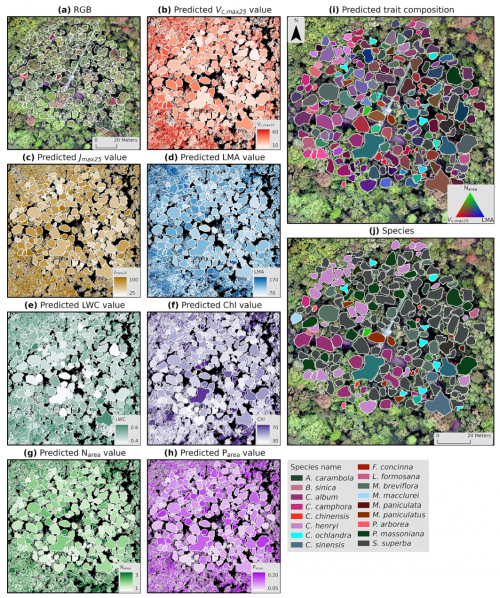Maps of canopy tree-crown RGB image based on a UAS survey at the Mt. Dinghu site (a), spatial variations in the seven traits (b-h), RGB composited image (i) of Vc,max25 (red), Narea (green) and LMA (blue), and field-identified tree species distribution (j). In panel (j), the colors represent different tree species, with a total of 17 canopy tree species.
The correct understanding and modelling of carbon fluxes of terrestrial ecosystems with climate change is limited by the accurate parameterization of plant photosynthesis related to foliar photosynthetic capacity. Vegetation spectroscopy has been increasingly suggested as an accurate, promising approach for characterizing leaf photosynthetic capacity. However, the capability and cross-site generalizability of imaging spectroscopy to enable this characterization in natural forest canopies from tree individuals to forest ecosystems and the associated leaf-to-canopy upscaling processes of spectra-trait relationships remain incomplete.
New research conducted by the Global Ecology and Remote Sensing (GEARS) Lab at HKU, including Dr. Jin Wu (PI of the lab), Mr. Shuwen Liu (PhD candidate of the Lab), Dr. Zhengbing Yan (former lab postdoc fellow and now staff scientist at Institute of Botany, Chinese Academy of Sciences), and many excellent collaborators across reputed institutes from Hong Kong, Mainland China, Netherlands, United States, and South Korea, has demonstrated that imaging spectroscopy onboard an unmanned aerial system (UAS) platform can be used to map foliar physiological traits at various scales, from tree individuals to contrasting forest landscapes.
Specifically, in two forest sites in China, ground measurements of leaf spectra and traits were collected, including biochemical, morphological, and physiological traits. Using a partial least-squares regression approach, the scientists built and tested spectra-trait models with repeated cross-validation. The UAS-based imaging spectroscopy proved to be an effective and general approach for inferring tree-crown-scale foliar photosynthetic capacity and other ecologically important foliar traits. The technique also helps to map multi-dimensional foliar traits with spatially explicit information, offering a critical dataset to assess the foliar trait variability and trait-trait coordinated relationships across the intra- and inter-specific levels.
“Our study showed that using UAS-based imaging spectroscopy can accurately measure important physiological traits for tree canopy photosynthesis,” said Dr. Zhengbing Yan. “We found that the relationships between spectral data and foliar traits differ across leaf and canopy levels, which complements previous studies on leaf optical properties as the basis for canopy imaging spectroscopy,” added Mr. Shuwen Liu. “Scaling plant functional traits from individual trees to forest ecosystems is critical but challenging. The success of our pilot study suggests that imaging spectroscopy can significantly advance research in plant functional ecology and global change ecology, providing unprecedented data and opportunities to assess forest ecosystem sensitivity to climate change and underlying biological scaling processes”, concluded by Dr. Jin Wu.
In the next step, the GEARS lab intends to use imaging spectroscopy techniques on larger spatial and temporal scales to address key ecological and climate change questions. The findings from this research will provide valuable scientific data to comprehend the diverse range of forest ecosystems and assess their ability to withstand climate change.
The findings were recently published in Remote Sensing of Environment, and the journal paper can be accessed from here.


